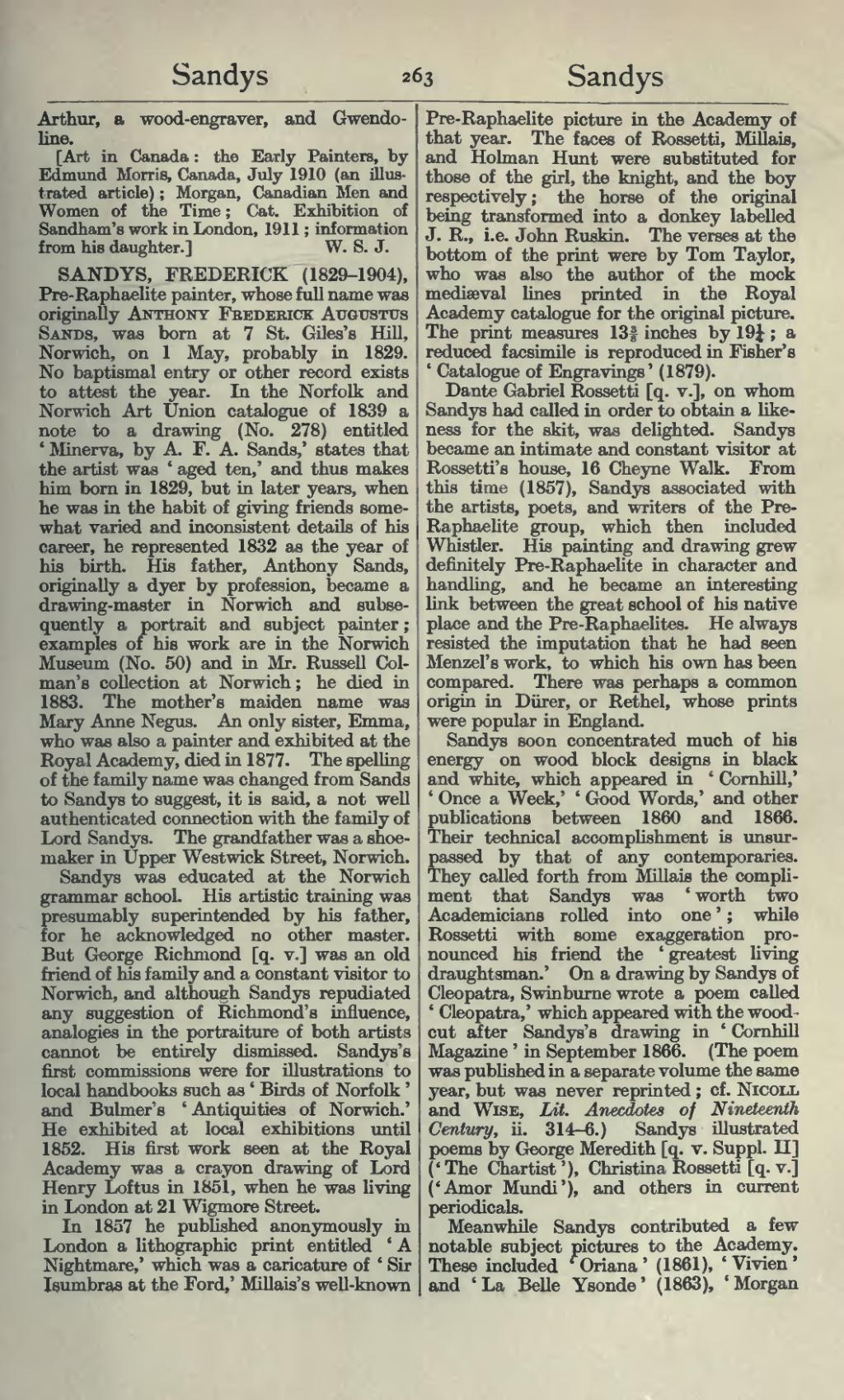Arthur, a wood-engraver, and Gwendoline.
[Art in Canada: the Early Painters, by Edmund Morris, Canada, July 1910 (an Illustrated article); Morgan, Canadian Men and Women of the Time; Cat. Exhibition of Sandham's work in London, 1911; information from his daughter.]
SANDYS, FREDERICK (1829–1904), Pre-Raphaelite painter, whose full name was originally Anthony Frederick Augustus Sands, was born at 7 St. Giles's Hill, Norwich, on 1 May, probably in 1829. No baptismal entry or other record exists to attest the year. In the Norfolk and Norwich Art Union catalogue of 1839 a note to a drawing (No. 278) entitled 'Minerva, by A. F. A. Sands,' states that the artist was 'aged ten,' and thus makes him born in 1829, but in later years, when he was in the habit of giving friends somewhat varied and inconsistent details of his career, he represented 1832 as the year of his birth. His father, Anthony Sands, originally a dyer by profession, became a drawing-master in Norwich and subsequently a portrait and subject painter; examples of his work are in the Norwich Museum (No. 50) and in Mr. Russell Colman's collection at Norwich; he died in 1883. The mother's maiden name was Mary Anne Negus. An only sister, Emma, who was also a painter and exhibited at the Royal Academy, died in 1877. The spelling of the family name was changed from Sands to Sandys to suggest, it is said, a not well authenticated connection with the family of Lord Sandys. The grandfather was a shoemaker in Upper Westwick Street, Norwich.
Sandys was educated at the Norwich grammar school. His artistic training was presumably superintended by his father, for he acknowledged no other master. But George Richmond [q. v.] was an old friend of his family and a constant visitor to Norwich, and although Sandys repudiated any suggestion of Richmond's influence, analogies in the portraiture of both artists cannot be entirely dismissed. Sandys's first commissions were for illustrations to local handbooks such as 'Birds of Norfolk' and Buhner's 'Antiquities of Norwich.' He exhibited at local exhibitions until 1852. His first work seen at the Royal Academy was a crayon drawing of Lord Henry Loftus in 1851, when he was living in London at 21 Wigmore Street.
In 1857 he published anonymously in London a Uthographic print entitled 'A Nightmare,' which was a caricature of 'Sir Isumbras at the Ford,' Millais's well-known Pre-Raphaelite picture in the Academy of that year. The faces of Rossetti, Millais, and Hohnan Hunt were substituted for those of the girl, the knight, and the boy respectively; the horse of the original being transformed into a donkey labelled J. R., i.e. John Ruskin. The verses at the bottom of the print were by Tom Taylor, who was also the author of the mock mediaeval lines printed in the Royal Academy catalogue for the original picture. The print measures 13¾ inches by 19 ¼; a reduced facsimile is reproduced in Fisher's 'Catalogue of Engravings' (1879).
Dante Gabriel Rossetti [q. v.], on whom Sandys had called in order to obtain a likeness for the skit, was delighted. Sandys became an intimate and constant visitor at Rossetti's house, 16 Cheyne Walk. From this time (1857), Sandys associated with the artists, poets, and writers of the Pre-Raphaelite group, which then included Whistler. His painting and drawing grew definitely Pre-Raphaelite in character and handling, and he became an interesting link between the great school of his native place and the Pre-RaphaeHtes. He always resisted the imputation that he had seen Menzel's work, to which his own has been compared. There was perhaps a common origin in Dürer, or Rethel, whose prints were popular in England.
Sandys soon concentrated much of his energy on wood block designs in black and white, which appeared in 'Cornhill,' 'Once a Week,' 'Good Words,' and other publications between 1860 and 1866. Their technical accomplishment is unsurpassed by that of any contemporaries. They called forth from Millais the compliment that Sandys was 'worth two Academicians rolled into one'; while Rossetti with some exaggeration pronounced his friend the 'greatest Uving draughtsman.' On a draing by Sandys of Cleopatra, Swinburne wrote a poem called 'Cleopatra,' which appeared with the wood-cut after Sandys's drawing in ’Cornhill Magazine' in September 1866. (The poem was published in a separate volume the same year, but was never reprinted; cf. Nicoll and Wise, Lit. Anecdotes of Nineteenth Century, ii. 314-6.) Sandys illustrated poems by George Meredith [q, v. Suppl. II] ('The Chartist'), Christina Rossetti [q. v.] ('Amor Mundi'), and others in current periodicals.
Meanwhile Sandys contributed a few notable subject pictures to the Academy. These included 'Oriana' (1861), 'Vivien' and 'La Belle Ysonde' (1863), 'Morgan

